If you happened to enter a hotel lobby or some other location and encountered this receptionist, would you sense anything peculiar about her? Or would she pass as normal?
A humanoid robot ‘receptionist’ recently (a year ago is still ‘recently’ to me) unveiled at Nanyang Technological University in Singapore, ‘Nadine‘ is able to function in a remarkably human-like manner, is able greet visitors and remember their names, and even remember conversations they have previously had. She shakes hands with visitors, waves them goodbye, is able to smile at visitors, and possesses the human touch of looking into people’s eyes when communicating.
Extending their focus to psychology and to linguistic communication, the Nanyang reseachers have gone beyond the traditional robotics fields of engineering and computer science in their attempts to further bridge the distinction between human beings and artificial intelligence.
While ‘Nadine’ isn’t necessarily designed to trick people into thinking they’re dealing with a human being, she is meant to help people relate to her more and more as if she were just an ordinary person.
“Our team have been fostering cross-disciplinary research in social robotics technologies,” Nadia Thalmann (on whom ‘Nadine’ is modelled) explains, “to transform a virtual human, from within a computer, into a physical being that is able to observe and interact with other humans. This is somewhat like a real companion that is conscious of what is happening,” she explains. “So in future, these socially intelligent robots could be like C–3P0… with knowledge of language and etiquette.”

Unlike C3PO, however, ‘Nadine’ and other humanoid-robots developed in recent years are specifically designed to look human and to mimic human behaviour, making them more like Data from Star Trek.
“As countries worldwide face challenges of an ageing population, social robots can be one solution to address the shrinking workforce, become personal companions for children and the elderly at home,” Thalmann explains, “and even serve as a platform for healthcare services in future”.
Looking at ‘Nadine’ naturally feels like a glimpse into a not-so-far-off future where artificial, humanoid life-forms could be a highly integrated part of the societal landscape. Not merely a robotic work-force, but highly humanised ‘life-forms’ designed to interact with human beings in increasingly social, adaptive manners.
It also highly reminiscent of the highly acclaimed Channel 4 (UK) TV series, Humans, which explores the themes of AI and robotics, focused mainly on the social, cultural and psychological aspect/impact of highly anthropomorphic robots and their interactions with human beings. Humans is a very good series that I highly recommend; while it manages to be eerie in much of its depiction of the humanoid AI, it also manages to portray palpable humanity in the non-human constructs, which are increasingly capable of great levels of human-like sensitivity.
It is in this context that serious, academic consideration is afforded to the idea of AI and robotics being utilised in health and social care.
And the ‘Social Care Robot Challenge 2017‘ is seeking to bring together experts in both industry and academia, to establish models for how robots will be integrated into the healthcare services of the future.
‘Nadine’ of course isn’t the first extremely life-like humanoid/robot to have been unveiled. Highly humanised AI has been developing at a great pace, particularly in Japan.
There was, for example, the world’s first news-reading android in Japan.
And Japanese robot designer Hiroshi Ishiguro left people marveling with his ‘Geminoid F’: a female/android who, aside from a range of facial expressions and vocal/linguistic skills, can also sing. She was regarded as so passably lifelike that she was even used as an actress in a play in Tokyo.
Professor Hiroshi Ishiguro also apparently has a humanoid version of himself that he sometimes sends overseas to give lectures.
–
–
More extraordinarily, there is Bina48 (see here) – an AI that has had the real memories, beliefs and core personality of a real-life woman transferred into it/her.
The woman/android was modelled on Bina Rothblatt, who was interviewed for over 20 hours on a variety of personal matters, with the transcribed conversation then uploaded to the AI database. Bina48 is a sophisticated creation, able to react to negative interactions (racism, for example), understand (and even tell) jokes, and comfortably discuss philosophical matters.
This idea of transferring the ‘real’ personality of a living human into an artificial being/intelligence takes things in an even more fascinating direction and opens the door to a form of quasi-immortality that might one day be available to all people.
While consciousness itself (depending on our definition of consciousness) will almost certainly never be transferable, something reasonably close to it may be possible.
While these advances are still presently in the novelty stage, at this rate of development it might not be too many years before very advanced AI in humanoid form is more commonplace. Your children or your children’s children might be interacting with Nadine-like constructs in a commonplace, even naturalised manner.
Whether that’s a good or bad thing depends of course on personal opinion; but aside from the usual schools of Luddite objection or resistance that often crop up in response to stories like these, the evolution of AI in this direction is probably inevitable and may in fact prove very useful in various ways, even if there may be certain problems that stem from it.
In fact, one of the most interesting ‘robot’ stories I came across lately was the suggestion that robot ‘brothels’ could soon become a thing. Which sounds useful. However, these things tend to veer into uncomfortable territory too: such as previous discussion of ‘child robots’ being possibly designed to ‘help’ serial child (sexual) abusers.
____________
Getting back to the question this post began with: would you sense anything different about ‘Nadine’ if you encountered her or would she pass as a normal receptionist?
You probably would discern something off about her from the start, as there is still a slightly eerily vacant demeanour. As impressive as she is, we’re still not quite at the place yet where most of us would be fooled. But we’re no doubt getting there fast, potentially soon reaching a point where the ‘uncanny valley’ effect is overcome.
All of that being said, it also occurs to me that there are sometimes real, living humans who strike us as odd in a not-too-dissimilar way.
You might think Nadine is a little off somehow, for example, but might assume she’s some who is heavily medicated. Take a look at this eerie footage of Senator Ted Cruz and his wife. There is no difference – at least not to the eye – between Mrs Cruz and the robot ‘Nadine’.
Whether Mrs Cruz is heavily medicated, under some form of mind-control, is a robot experiment or just has a very odd manner about her, the fact is if you were shown this footage out-of-context and told it was footage of a new, humanoid-robot being developed in Japan, you might not have any reason to think otherwise.
–
–
I’m pretty sure I’m *not* saying doppelganger robots are secretly replacing politicians and their wives in some sinister takeover bid; but Mr and Mrs Cruz are proof that you could insert an artificial lifeform into a real-world scenario and not necessarily arouse suspicion. Over the years, I’ve seen footage of a number of people – including famous figures like Hillary Clinton and several Chinese politicians – and thought I might be looking at an artificial life-form or replicant.
Again, NOT saying AI doppelgangers have been impersonating real people – just raising the point that we apply the uncanny valley issue to AI all the time, but usually don’t ask whether *real-life people* are actually effectively passing the same test.
______________




With our great human intelligence, we are working towards our own obsolescence.